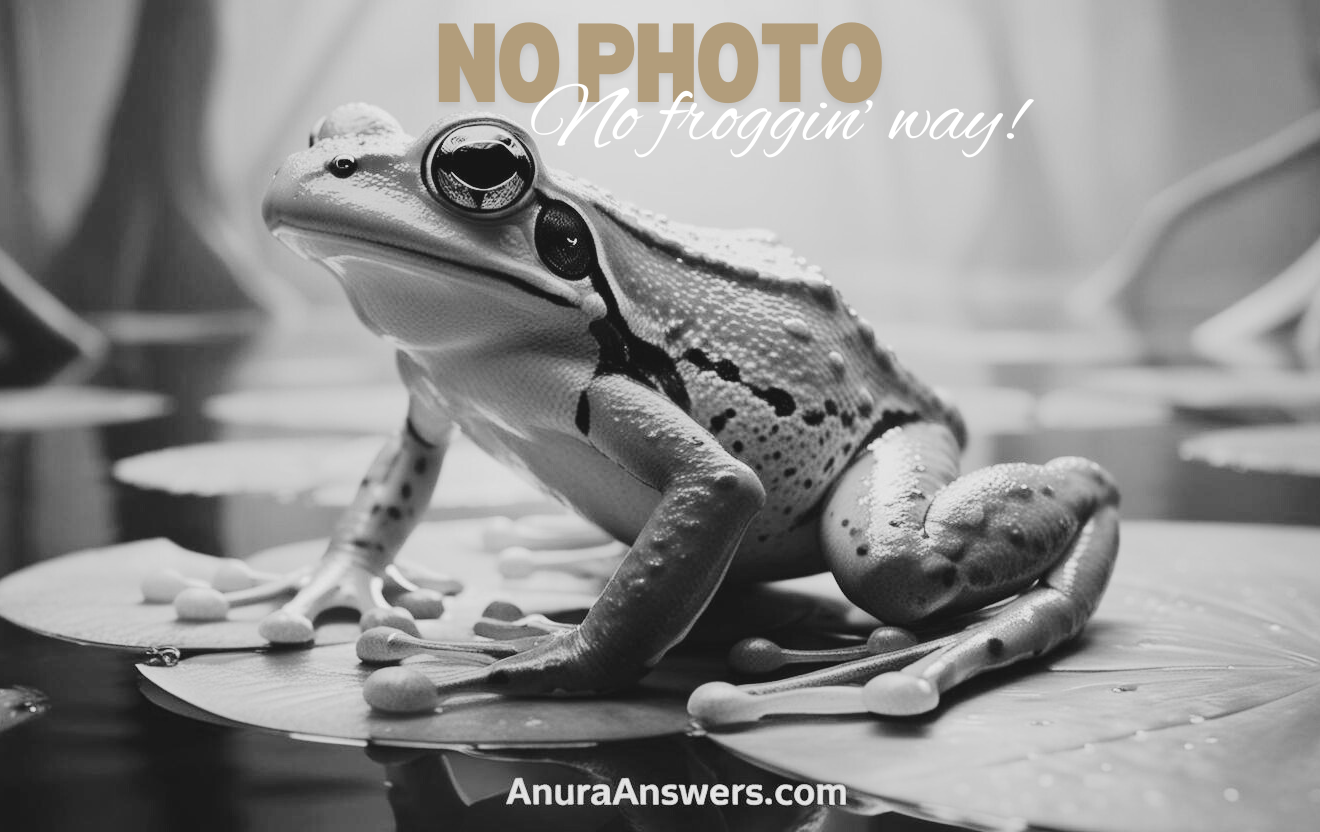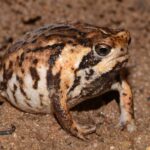- Unveiling Nature's Jewel: The Elegant Long-Fingered Frog (<em>Cardioglossa elegans</em>)
- Taxonomy and Classification: Unraveling Its Lineage
- Natural Habitat: Life Amidst the Green Symphony
- Physical Characteristics: Nature's Artistic Brushstroke
- Behavior and Life Cycle: Harmony in the Forest Rhythm
- Ecological Role: Guardians of Balanced Ecosystems
- Threats and Conservation Status: Preserving an Elegant Survivor
- Cultural and Scientific Significance: Bridging Nature and Humanity
- Conclusion: Celebrating a Jewel of Biodiversity
Unveiling Nature’s Jewel: The Elegant Long-Fingered Frog (Cardioglossa elegans)#
Hidden amidst the lush greenery and melodic symphony of Central Africa’s rainforests resides an enigmatic amphibian whose delicate beauty and secretive lifestyle have charmed scientists and naturalists alike: the Elegant Long-Fingered Frog, known scientifically as Cardioglossa elegans. Possessing captivating coloration and remarkable adaptations, this frog tells an intriguing tale of survival and ecological connectivity woven delicately into the fabric of the rainforest ecosystem. Few creatures epitomize nature’s diversity and interconnectedness quite like this charismatic amphibian, inviting us to explore deeper into its mysterious world.
Taxonomy and Classification: Unraveling Its Lineage#
Cardioglossa elegans is part of the Arthroleptidae family, distinguished carefully from other tropical frogs by specialized anatomical features. The genus name “Cardioglossa” itself—a fusion derived elegantly from Greek origins meaning “heart-tongue”—alludes poetically to the uniquely shaped heart-like structure of their tongues. Within the genus, which comprises multiple intriguing species, C. elegans stands out notably for its elegant appearance and distinctive features.
This frog bears close genetic relationships with others in its genus, including Cardioglossa gracilis and Cardioglossa leucomystax, their subtle yet meaningful variations providing insights into the evolution and adaptive strategies of this fascinating lineage.
Natural Habitat: Life Amidst the Green Symphony#
Deep within the verdant rainforest corridors stretching across Cameroon, Equatorial Guinea, Gabon, and Nigeria, the Elegant Long-Fingered Frog claims its territory. Preferring lowland and mid-altitude forests, often where humidity hangs thickly in the air, these amphibians thrive around shaded streams, gently flowing rivers, wet forest floors, and occasionally near forest edges where moisture levels remain constant.
Imagine entering their habitat at dusk: the air would vibrate with choruses of insects and amphibians, dense foliage enveloped in twilight misty veils. The quiet trickle of forest streams further enhances an atmosphere designed perfectly for these frogs, as amphibians inherently depend on moisture to maintain their delicate skin.
An Intimate Dance With Their Environment#
The Elegant Long-Fingered Frog isn’t merely a passive creature within its home; rather, it actively interacts with its ecosystem at multiple ecological levels. It relies heavily on damp microhabitats, such as immersed leaf litter or moss-covered stones near flowing water, using the intimate complexities of its rainforest home for refuge from predators and environmental extremes.
This preference for microhabitats points to its vulnerability; even minute changes to forest structure—like deforestation or selective logging—pose significant threats to its survival, reinforcing the necessity of habitat conservation efforts.
Physical Characteristics: Nature’s Artistic Brushstroke#
If nature were a painter, the Elegant Long-Fingered Frog would rank among its most exquisite masterpieces. Generally small in stature—adult frogs measuring only around 2-3 centimeters—its size belies its remarkable allure. Durable yet fragile, its skin shimmers subtly, adorned neatly by patterns of bold stripes or dots in beautiful palettes ranging from bronze tones and vivid browns to varying shades of earthy olive-green. These intricate markings help camouflage these tiny creatures effectively among dappled leaf litter and mossy surfaces, blending them seamlessly with their surroundings.
Unique Morphological Adaptations#
Notably captivating are their fingers—long and slender, from which the species earns its evocative common name. Equipped with conspicuously expanded finger pads, these delicate yet surprisingly robust appendages enable them to navigate effortlessly and gracefully through tangled vegetation; climbing vines and leaves with such precise dexterity reflects remarkable evolutionary adaptation to their complex arboreal and terrestrial habitats.
Another intriguing characteristic pertains to their tongues: the famously heart-shaped structure assists significantly in capturing and securing prey, making them efficient predators despite their diminutive size. Each intricate feature of their physiology demonstrates nature’s artistry and adaptive craftsmanship.
Behavior and Life Cycle: Harmony in the Forest Rhythm#
Beneath their fragile-seeming appearance resides resilience impressive beyond mere visual elegance. Nocturnal by nature, the Elegant Long-Fingered Frog spends daylit hours sheltered securely beneath leaf debris or moss-covered crevices, emerging at dusk when predation threats decline.
A Skilled Predator of the Dark Hours#
Under the muted glow of moonlight filtering gently through dense foliage, these tiny frogs engage in their nightly quest for food—feasting primarily on small arthropods and insects. Employing a sit-and-wait hunting strategy, they patiently await unsuspecting prey, swiftly striking with impressive accuracy thanks to their specialized tongues. This strategic patience highlights both their inherent biological adaptability and imperative ecological role as insect regulators.
The Enchanting Rituals of Reproduction#
The onset of rainy seasons triggers vibrant reproductive activities among Elegant Long-Fingered Frogs. Males take prominent positions around their favored streams, vigorously emitting distinctive yet melodious trills and chirps that resonate gently through the undergrowth, attracting receptive mates. Upon forming successful pairings, females subsequently deposit small clusters of gelatinous eggs securely hidden within damp leaf litter adjacent to water bodies, occasionally directly in shallow pools.
After their meticulous laying, embryos develop rapidly; within days, wiggling tadpoles hatch, descending quickly and cautiously from leaf structures into surrounding streams. Here, these tiny aquatic beings commence transformation from aquatic to terrestrial lifestyles—a wondrous metamorphosis journey marked by vulnerability yet symbolizing life’s resilience.
Ecological Role: Guardians of Balanced Ecosystems#
Cardioglossa elegans serves as an integral player within Central Africa’s rainforest ecology—both predator and prey within elaborate food chains. The frogs’ predatory behavior keeps insect populations balanced, reducing likelihood of pest outbreaks detrimental to surrounding flora. Conversely, they themselves are prey for myriad forest species, from birds and snakes to small mammals and larger frogs, highlighting their dual responsibility within nature’s delicate equilibrium.
An Indicator Species for Ecosystem Health#
The sensitivity of amphibians like Cardioglossa elegans to environmental disturbances positions them ideally as bioindicators, creatures whose health directly reflects overall environmental well-being. Declines in populations signal ecosystem stress—often witnessed preceding more profound ecological breakdown—thus emphasizing conservation’s necessity.
Threats and Conservation Status: Preserving an Elegant Survivor#
Alarmingly, habitat degradation emerges as one of the predominant threats facing the Elegant Long-Fingered Frog, driven chiefly by deforestation for logging, agriculture expansion, human settlement, and infrastructural development. Shifts in climate patterns complicate matters further, altering precipitation regimes crucial for reproduction cycles and breeding habitats. Consequently, conservationists prioritize habitat restoration alongside sustainable land use practices supporting amphibian resilience.
Fortunately, according to the International Union for Conservation of Nature’s (IUCN) assessments, the species currently occupies the status of Least Concern. Nevertheless, this status underscores vigilance and commitment to protective measures ensuring future survival amidst mounting environmental pressures.
Cultural and Scientific Significance: Bridging Nature and Humanity#
Although not commonly influential in mythological tales, amphibians like Cardioglossa elegans, due to their charismatic appearance and fascinating behavior, increasingly capture human imagination, becoming symbols for environmental harmony and hope among local communities and environmental education campaigns throughout their range.
Scientifically, their unique biology has provided insights into evolutionary biology, ecological dynamics, and even environmental toxicology studies, significantly enriching scientific understanding of amphibians broadly, their habitats, and intricate responses to environmental fluctuations—a veritable wealth of knowledge crucial for broader ecological stewardship.
Conclusion: Celebrating a Jewel of Biodiversity#
The Elegant Long-Fingered Frog remains more than simply another amphibian living discreetly hidden within lush rainforest terrains; it symbolizes life’s resilience, biological diversity, ecosystem balance, and ultimately, hope itself. Understanding its biology, ecological connectivity, and importance in environmental stability compels an appreciation deeper than superficial beauty alone.
By promoting awareness, supporting conservation initiatives, and nurturing respect for even the smallest rainforest creatures, we ensure continued existence for remarkable species like Cardioglossa elegans. Let us champion these hidden treasures, safeguarding their habitats, and celebrating their role as vital guardians enriching our shared planet.










